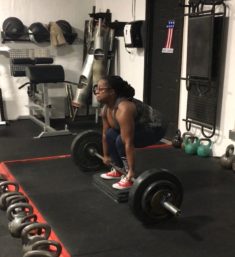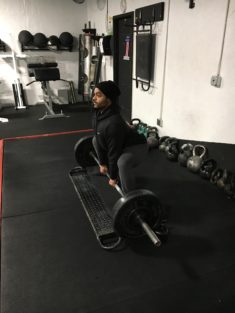Written by: Kevin Cann
I chose to work with Boris Shieko as my coach for a couple of reasons. For one, he is the most decorated coach in the sport of powerlifting. Another reason is how different they do things in Russia compared to here in America. I wanted to step outside of my comfort zone and learn some things for myself.
One of the different pieces of a Shieko program was his use of deficit deadlifts. If you do a search for deficit deadlifts on the internet you will mostly likely find information saying that no more than an inch or two is necessary.
You will also find some articles vilifying deficit deadlifts. This is most likely due to the difficulty in maintaining a neutral spine with the greater range of motion. Here in America there are not too many things we fear more than rounding our spine.
The problem with this is that our spine is meant to be round. We possess between 40 and 60 degrees of lumbar flexion, depending on the source. Under submaximal weights and creating as much intraabdominal pressure as possible, we can keep our lower backs safe when lifting things.
Many lifters, both experienced and novice, have a hard time getting into the proper deadlift position. To fix this issue many lifters and coaches will work stretching the hamstrings and rolling on a foam roller to loosen up their thoracic spines. They do this only to get under the bar and have the same position as they had before.
Often times the issue is not a mobility issue, but a motor control issue. Even if it was a mobility issue, we may not be strong enough to hold that position under heavier weights. In order to fix our deadlift start position, we need to stress that position enough to overload the nervous system as well as get stronger in that position.
For these reasons, Sheiko prefers using a larger deficit. He recommends a deficit of 10cm which is roughly 4 inches. At this deficit height, the back will round a little. The goal is to make the athlete fight hard for a good position. We are using this to fix the start position for the competition lift.

The one to two inches is not enough to make the athlete have to fight for a better position. We talk about the overload principle for volume and intensity, but it also matters for motor control as well. One to two inches is not enough to overload the system to improve positions.
Under submaximal weights and creating intraabdominal pressure (bracing), a rounded back is not dangerous. We have to round our back to pick up uniquely shaped objects. The deficits are to improve technique, so the intensity should be between 60% and 70%. This is usually done for four to five sets of two to three reps.
Under these conditions risk is still relatively low. The 10cm deficit applies to both conventional deadlifts and sumo deadlifts. It seems many more will argue against the larger deficits, or deficits in general, for the sumo deadlift. This is due to the difficulty in the sumo deadlift breaking the floor. For that reason alone I may argue that there is greater carryover to improving the strength off of the floor in the sumo deadlift from performing deficit deadlifts.
The weak spot for the conventional deadlift is just below the knees. However, if we do not reach that sticking point in a good position, we will limit how much we can lock out. The bigger deficit also puts more stress on the muscles involved in the deadlift off of the floor. Your legs must work harder to get the weight moving, and your back needs to keep pulling through a larger range of motion.
I have heard arguments against the deficit deadlift for the sumo deadlift due to injury risk. I don’t understand this thinking. With the deficit we get increased hip flexion, increased knee flexion, increased ankle dorsiflexion, and maybe 5 degrees of increased torso lean.
This puts more stress on the extensors of all of those joints and a hair more shear force on the spine. However, this is still a high squat. Hips will still be above parallel. This makes the lower body position similar to a wide stance high squat. This does not concern me, as we squat below parallel. This is similar to a multiply lifter performing high box squats with their competition stance.

The increased torso lean does put more shear force on the spine. However, the sumo deadlift has 5 to 10 degrees less torso lean than a conventional deadlift. The 5 degree increase would only make it similar to a relatively upright conventional pull from the floor.
Many people that pull sumo prefer it because it allows them to hide their weak back strength. This is why adding deficits would be important. They can help strengthen weak muscle groups, which will only make their deadlifts better, and their squat for that matter.
If you are having difficulty with the start position of the deadlift, add in some deficits. The height of the deficit should be around 4 inches to force us to have to fight hard for a good position. Don’t worry about rounding your back, just use weights between 60% and 70% for four to five sets of two to three reps and brace appropriately. To get more bang for your buck, lower the bar under control. This will help improve mobility even more than passively stretching your hamstrings.

I just love dead-lifts. I just try every type of deadlift including Sumo, Conventional, Romania, Stiff Leg, Dumpbell deadlift.